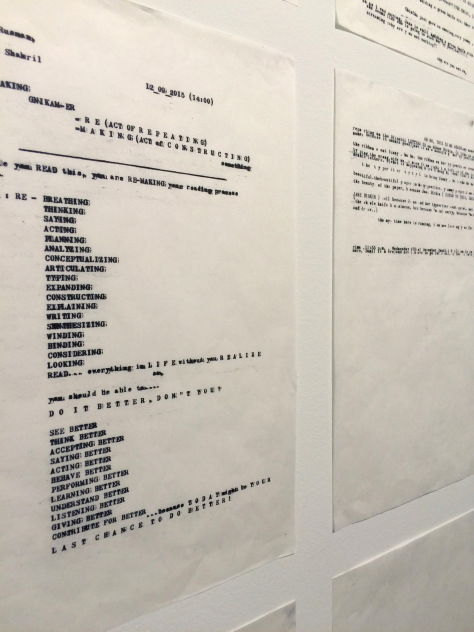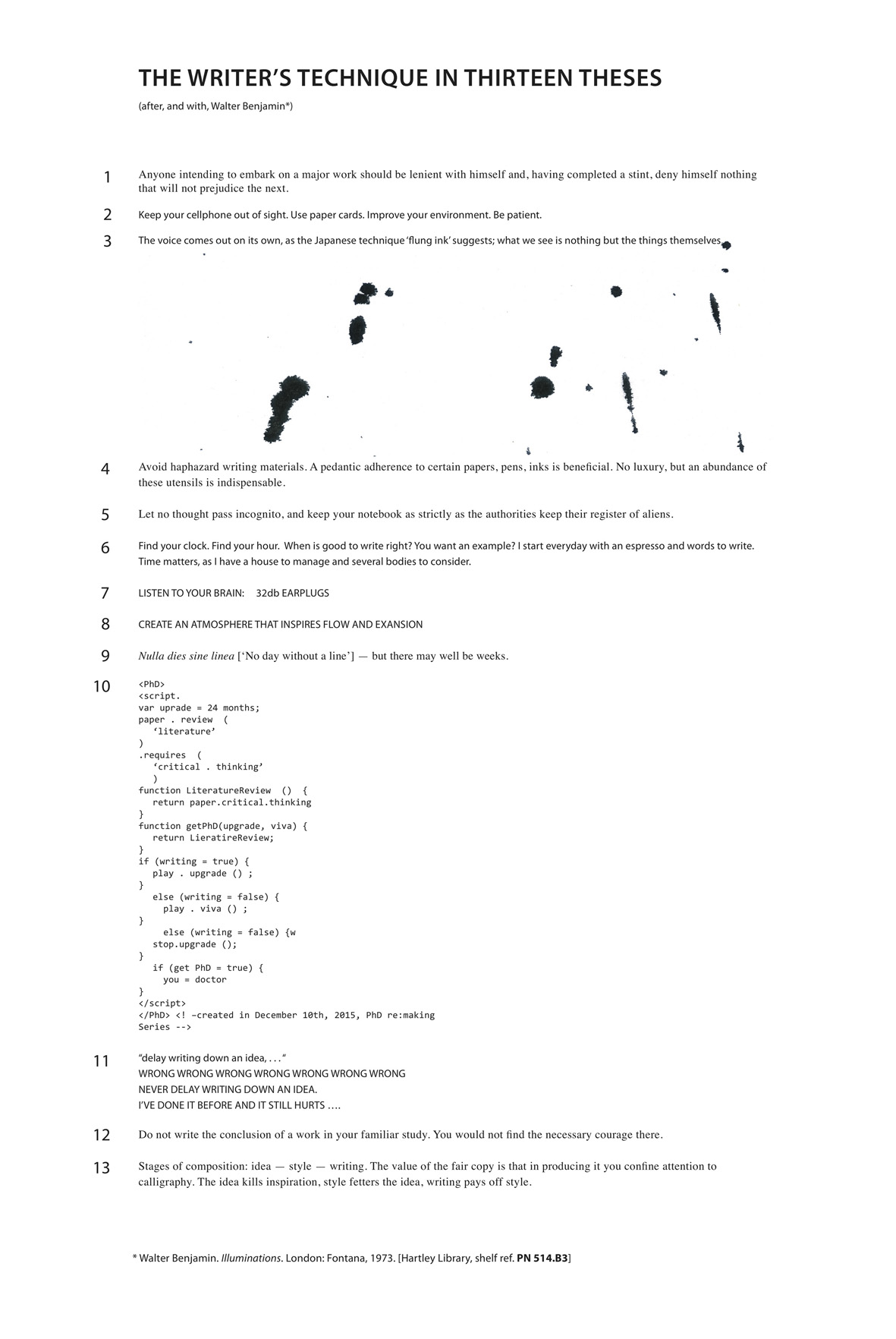For a final seminar of the autumn semester 2015, Writing as Making, we gathered for two days to work as a community of writers. Picking up from the Practices of Research exhibition that was held in 2014, which presented work of 16 PhD students and two members of staff, the idea for this seminar was again to acknowledge the diversity of research practices but also the fact that a written component must be submitted for all examined research, whether practice-based or not. As the rationale for Practices of Research put it:
Studio-based researchers in art and design work alongside those engaged in humanities and social science research, covering areas of art history, critical theory and curatorial practice, as well as the management and marketing of advertising, design, media, fashion, textiles and luxury branding. All researchers at the School are engaged in the critical making of new knowledge: each moving in and out of complex and disciplined modes of activity. Whether it is reading, writing, looking, making, coding, speaking, recording, and much else besides, each are forms of imaginative and critical engagement, developed and extended within the context of a collaborative and inter-disciplinary research community.
As a form of writing retreat, the primary aim of Writing as Making was to provide dedicated time to write, but also to share in the act of writing, and as such to reflect critically on various strategies. There were three main interventions. Firstly, all participants were asked to consider how at sentence level they pursue a form of critical writing. A simple technique used in schools known as PEA or PEE (Point, Evidence, Analysis, or Explanation) was put before everyone, in effect as a provocation, to question how both arguments and analysis are drawn out from the materials we are citing and synthesising. Like the writing through a stick of rock, are the points we wish to make working their way through each and every sentence. Is there an underlying coherence to our work?
A second intervention was a typewriter. This was placed in the room on its own desk, with all participants encourage to take ‘time-out’ from their own work to experiment with this now defunct tool for writing and printing. As Friedrich Kittler suggests, ‘[r]eading functions as hallucinating a meaning between letters and lines’, and as corollary to which the medium through which we write effects how we think (or ‘hallucinate’). According to Kittler, when philosopher Friedrich Nietzsche turned to using the typewriter his prose ‘changed from arguments to aphorisms, from thoughts to puns, from rhetoric to telegram style’. Part of the change in style reflects the practicalities of using the device. As Emden suggests, Nietzsche found using the typewriter ‘more difficult than the piano, and long sentences were not much of an option’. With Nietzsche’s eyesight failing, the ability to ‘feel’ his way through writing was appealing, but arguably the technology then has a profound impact on the status and nature of his philosophising. As Kittler writes:
Neitzsche’s reasons for purchasing a typewriter were very different from those of his colleagues who wrote for entertainment purposes, such as Twain, Lindau, Amytor, Hart, Nansen, and so on. They all counted on increased speed and textual mass production; the half-blind, by contrast, turned from philosophy to literature, from rereasing to a pure, blind, and intransitive act of writing.
Quite aside from any romance we might now associate with the typewriter – as a signifier of a golden age of modernist writing and criticism – the clatter of the machine proved too much for some of the seminar participants. While individuals became quite engrossed in typing, the thud thud of the device meant others buried themselves in their headphones to listen privately to music as they worked.
The ambivalence of the typewriter in the room (and the wild sheets of paper that came out of it) relates well to the writer, Walter Benjamin, who became the third intervention for the seminar. In his One Way Street, published in 1928, Benjamin argues, in a section titled ‘Teaching Aid’, that the typewriter ‘will alienate the hand of the man of letters from the pen only when the precision of typographic forms has directly entered the conception of his books. One might suppose that new systems with more variable typefaces would then be needed. They will replace the pliancy of the hand with the innervation of commanding fingers.’ However, it is in the section shortly after this, ‘Post No Bills’, that gave impetus for a collaborative outcome of the seminar. In this section, Benjamin offers ‘The Writer’s Technique in Thirteen Theses’. All participants were invited to contribute an entry for a new version, or re-making of this text. What emerged was a highly eclectic set of thoughts and missives. Of course, unlike the authoritative (even pompous) voice of single author, as in the case of Benjamin, the new text presents a much more heterogenous and fragmentary set of voices. It is also a much more immediate text, like a diary digest of the two day seminar marked out as concrete poetry, and which in fact we did choose (against Benjamin’s wishes?) to display as a bill poster for the Re: Making exhibition. Click on the image image to download a PDF version of the wall poster. As a document it quickly reveals writing as practice, as a working and re-working of texts in pursuit of new thoughts, images and confluences
References
Benjamin, W (1997) One-Way Street, trans. by Edmund Jephcott and Kingsley Shorter. Verso.
Emden, C. (2005) Nietzsche On Language, Consciousness, And The Body. University of Illinois Press.
Kittler, F. A. (1999) Gramophone, Film, Typewriter trans. by Geoffrey Winthrop-Young and Michael Wutz. Standford University Press
Return to Re: Making

